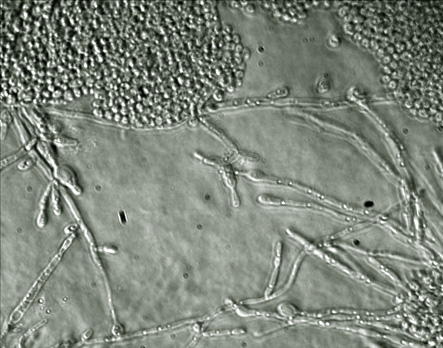By Rachel Tompa
Like many other normally harmless microbes, the yeast
Candida albicans is always with us - on the skin and in the gut, for instance.
But when conditions favor it,
Candida may grow conspicuous. For normally healthy people, the result may be vaginal infection, some form of diaper rash or oral thrush. These infections are uncomfortable, but rarely present serious risks.
For those with weak immune systems, however,
Candida infection is a different story. For example, patients undergoing treatment for organ transplants or cancer cannot easily fight
Candida growth, and
Candida infection leading to meningitis among newborn premature infants is a growing concern.
When the single-celled fungus gains the upper hand, it changes its itinerary. A multitude of cells invade the bloodstream. They travel throughout the body and can infect many organs. This scenario is known as systemic, or invasive, candidiasis. It can be fatal if not treated early.
 UCSF postdoctoral fellow Quinn Mitrovich at Mission Bay.
|
Quinn Mitrovich, PhD, a UCSF postdoctoral scientist, is investigating the molecular nuts and bolts of this pathogenic adaptation. He wants to know what allows
Candida to enter the bloodstream and bodily environs where it normally does not roam. Through his work in the labs of developmental biologist Christine Guthrie, PhD, and microbiologist Alexander Johnson, PhD, Mitrovich hopes to find ways to block these molecular events and halt raging
Candida infections.
The vagina, the bloodstream and the brain are quite different environments. It is unusual for a single pathogenic microbe to adapt so quickly to such different surroundings, Mitrovich explains. Yet
Candida is able to invade virtually every part of the body once systemic candidiasis sets in - leaving researchers mystified.
Rapid Splicing When Time is of the Essence
Some scientists have begun looking at changes in
Candida gene expression during different stages of infection. An expressed gene is one that is switched on. During gene expression, the genetic code is transcribed into an RNA messenger molecule. The RNA encodes a complementary message that is translated into protein within factories inside each living cell.
A trademark of any pathogen is the ability to change its gene expression in response to the host environment in order to elude the host immune response. But the fact that
Candida is able to invade every human organ "means that it is very adaptive," says Mitrovich. "We speculate that this involves multiple changes in gene expression."
There's a good chance the quick-change artistry of
Candida is due to a biological phenomenon known as RNA splicing, Mitrovich says. Similar to the way an audio or video engineer cuts and pastes interview footage to obtain the desired presentation,
Candida manipulates its own genetic blueprint. It cuts and pastes RNA to quickly change the proteins it makes.
 |
An image of the yeast Candida albicans, as grown in a laboratory dish, obtained with a light microscope. Some cells have assumed a small, round form, while others are long, filamentous hyphal cells. The ability to shift forms is thought to be crucial for invasion of - and survival within - the different tissues that Candida infects. Image/Quinn Mitrovich |
The impetus for Mitrovich's work came from observations made in another yeast species,
Saccharomyces cerevisiae - brewer's yeast. It does not cause disease. But of interest to those who study its sometimes fearsome fungal brethren, scientists working in Guthrie's lab found that RNA splicing in
S. cerevisiae is highly controlled, and that it occurs very quickly in response to different environmental conditions.
"The production of new RNA can be slow, whereas the splicing responses we see in
S. cerevisiae happen very rapidly - within a few minutes of exposure to a new environment," Mitrovich says.
Guthrie, Johnson and Mitrovich wondered whether something similar happens when the pathogenic yeast
Candida is exposed to different environments in the human body. "Splicing is a way for an organism to be poised to adapt - to move into a new environment quickly," Mitrovich says.
Secrets of Shape Shifting
While scientists do not yet understand the tricks
Candida uses to invade its host, they do know that this yeast takes on many different physical forms.
For example, it can exist in a "yeast" form, in which each cell is round and separate from other cells. It can also exist in a "hyphal" form, in which cells are elongated and attached to each other. There also are different physical forms associated with stages of mating.
The ability of
Candida to sample all these different forms is thought to be important in its success as an infectious pathogen.
Mitrovich is surveying the entire complement of
Candida genes - its genome - to find out how RNA splicing is involved as
Candida changes from one form to another. He has already seen intriguing changes in the splicing of a few specific genes when
Candida switches from one mating form to another.
Mitrovich hopes eventually to identify master regulators of splicing responses in
Candida. If
Candida is indeed using splicing regulation as a means to survive in the human body, then targeting the key proteins involved could be a new avenue for better drug therapies to fight infection.

